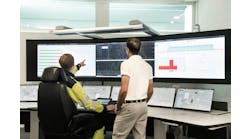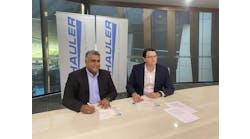A major talking point at last month's Honeywell Users' Group (HUG) Europe, Middle East & Africa (EMEA) conference in Lisbon, Portugal, was the news, announced with no small measure of glee by sales support director Jean-Marie Alliet and then subsequently re-announced by various members of the Honeywell OneWireless team, including Ignace Verhamme and Rama Budampati, that the long-awaited convergence of the rival ISA100.11a and WirelessHART standards for device-level wireless networking in the process industries isn't going to happen.
Single Standard Will Never Happen
Each was, in fact, relaying, in one form or another, a statement by Dick Caro, co-chair of the ISA-100.12 WirelessHART Convergence Subcommittee, which had already been reported on the Managing Automation web site. According to Caro, a veteran of the fieldbus wars of the '80s and '90s, "ISA-100.11a and WirelessHART are inherently incompatible from a standards viewpoint. In other words, to write a single standard from which you could pick a menu and come up with either 100.11 or WirelessHART from the same standard will never happen."
Caro's sub-committee had been set up at the time of the release of the WirelessHART standard two years ago to defuse the increasingly acrimonious relations between the advocates of the two putative standards, led on the ISA100.11a side by Honeywell and on the WirelessHART side by Emerson. Those relations reached their nadir in 2007 when the then Honeywell Process Solutions (HPS) president, Jack Bolick, contacted members of the HART Foundation immediately before the vote to release the HART 7 specification which incorporated WirelessHART, urging them to block the release.
The subcommittee's terms of reference had been to evaluate the two specifications and "offer a phased converged specification recommending technical changes necessary to converge the WirelessHART specification and ISA100.11a Release 1 standard" with the proviso that its efforts should be entirely independent of ISA100.11a standard development and would have "no affect [sic] on ISA100.11a schedules or any other ISA100 standards development efforts." It was that undertaking which gave many users the assurance that there would eventually be only one standard and the confidence to at least experiment with wireless using WirelessHART-based devices, until now the only devices available for wireless networking in process industry environments.
Two years down the road, however, and after detailed evaluation of their respective protocol suite, system management, gateway and security specifications, Caro says that "They are so different in detail that I don't know of anybody who is interested in writing a document that puts them together."
Fig Leaf?
In saying so he is simply reflecting the views of, among others, Penny Chen of Yokogawa and Hesh Kagan of Invensys, both of whom suggested as recently as last September that convergence would be difficult if not impossible. Nevertheless, Caro's statement will lead many observers and actual and potential users of WirelessHART, while in no way questioning the sincerity of his and his sub-committee's efforts, to wonder whether the underlying purpose of the whole exercise was to provide a fig leaf behind which development of ISA100.11a could be completed and, more importantly, submitted to IEC for consideration as an international standard before WirelessHART's earlier submission had been accepted.
Certainly the mood among Honeywell's wireless team was one of barely concealed triumph. Asked whether he believed that ISA100.11a and WirelessHART networks would now have to coexist within the same environment, Ignace Verhamme said that he could conceive of no situation in which a user would now wish to choose WirelessHART in preference to ISA100.11a, although Jean-Marie Alliet did concede the possibility of third parties developing gateways to enable sub-networks of WirelessHART devices to be incorporated into ISA100 networks.
Meanwhile, what of Caro's subcommittee? They, says Caro, are now developing a recommendation for a "dual boot" approach whereby vendors will incorporate both network stacks into their devices, leaving users to select their preferred network at configuration, a solution which he describes as "convergence at the device level." Whether a subsequent version of the standard would, in fact, make that mandatory and require a vendor to incorporate both stacks before a device could be stamped as ISA- compliant is unclear, however. More likely is that both standards will be incorporated into an eventual IEC standard without provision for interchangeability or interoperability.
Two-Headed Monster
Caro himself has, of course, been here before, having chaired the now infamous ISA SP50 fieldbus committee and acted as convener of the associated IEC SC65C committee, whose failure to gain approval for a single unified fieldbus specification finally resulted in the IEC imposing its own multiple standard solution for fieldbus networks, IEC 61158. "The IEC was responsible for the eight-headed monster that was fieldbus," said Caro, who resisted that decision to the bitter end and sounds as if he's still bitter about the outcome. "I think a two-headed monster for wireless will emerge from IEC."
One beneficiary of the decision to abandon convergence looks like being Atlanta, Georgia, and Bucharest, Romania-based Nivis which, in July of this year, released what was claimed to be the world's first ISA100.11a integration kit and, at last month's ISA Show and at HUG in Lisbon, was demonstrating a prototype 'dual boot' solution.
Baffled Users
How WirelessHART supporters in general and companies such as Emerson, which have invested heavily in the technology, will react to this latest development remains to be seen. Uncommitted users, however, must be as baffled as the majority of observers who, on the one hand, see advocates setting out what are claimed to be sound technical and business arguments for investing in one or the other technology while, on the other, their opponents don't just question the wisdom of such a decision, but impugn the sanity and indeed morals and parentage of anyone who might contemplate taking it. Perhaps greater clarity will emerge later this month when the European press reconvene in Holland to hear Emerson's version of the argument―but don't count on it.
- The ISA100 Wireless Compliance Institute (WCI) reports that it has successfully deployed, tested and approved ISA100.11a devices in a multi-vendor installation at an Arkema liquid organic peroxides plant at Crosby, Texas. The system has been operating since September 19, just 10 days after the standard was ratified, following parallel development of stacks, transmitters and compliance tools during the final stages of the standardization process. Vendors participating in the installation include Gastronics, Honeywell, Nivis, Wilson Mohr, Wireless Access Solutions (formally Gooch Engineering) and Yokogawa. Sensors from additional WCI supplier members will be added in succeeding months to cover applications including temperature, pressure, contact closure, valve positioning, gas detection and corrosion detection. The entire site is currently covered by two backbone connections and sensor meshing. "The ISA100.11a devices do work in a multi-vendor mesh with a common host system," explained Herman Storey, formerly of Shell Global Solutions. "The mesh dynamically handles re-routing in real time. Provisioning and commissioning is interoperable thanks to work done by WCI to provide support services and tools."
Meanwhile the ISA100.15 Working Group (WG15) is seeking technical presentations from wireless backhaul/backbone providers to form the basis of its recommended best practices and standards considerations for interoperability of wireless backhaul/backbone networks, wireless sensor networks and wireless devices usable by the process automation industry.



